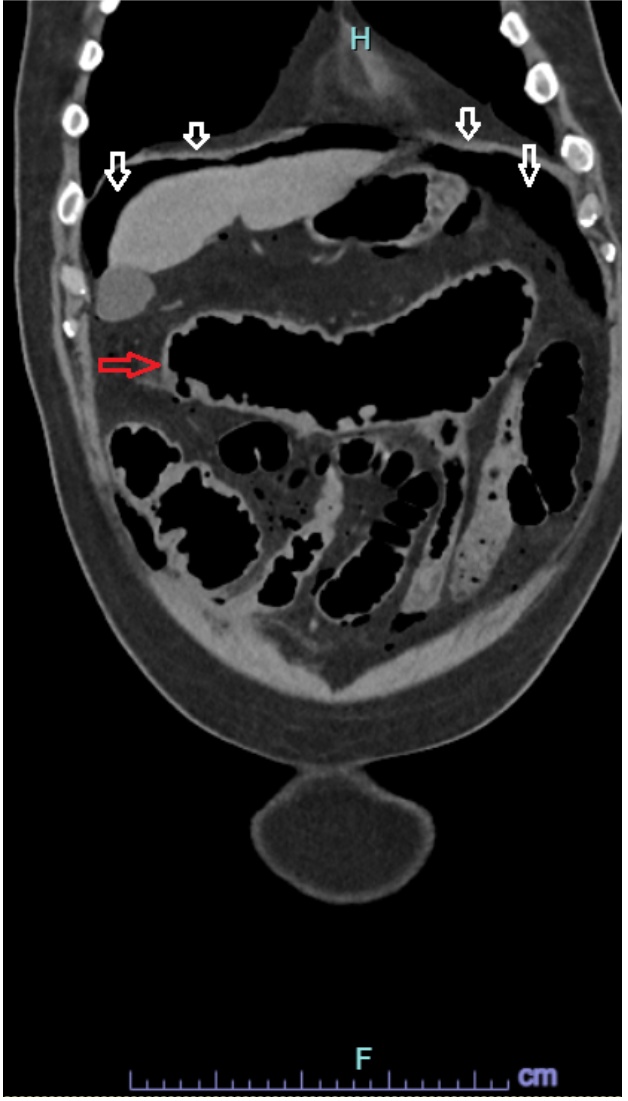Tuesday Poster Session
Category: IBD
Fulminant Ulcerative Colitis Following <i>Helicobacter pylori</i> Eradication: A Case Report
P5499 - Fulminant Ulcerative Colitis Following Helicobacter pylori Eradication: A Case Report
Tuesday, October 28, 2025
10:30 AM - 4:00 PM PDT
Location: Exhibit Hall

Abraham Tanousian, DO (he/him/his)
Sierra View Medical Center
Fresno, CA
Presenting Author(s)
Abraham Tanousian, DO1, Summera Majeed, MD2, Hema Aremanda, MD2
1Sierra View Medical Center, Fresno, CA; 2Sierra View Medical Center, Porterville, CA
Introduction: Ulcerative colitis (UC) is a chronic inflammatory bowel disease affecting the colon. Recent evidence suggests an inverse relationship between Helicobacter pylori infection and inflammatory bowel disease, with case reports describing IBD exacerbations following H. pylori eradication therapy.
Case Description/
Methods: A 54-year-old male with a 20-year history of well-controlled ulcerative colitis on mesalamine presented with severe abdominal symptoms three weeks after completing H. pylori eradication therapy (14-day triple therapy with clarithromycin, amoxicillin, and omeprazole). The patient had comorbidities including insulin-dependent diabetes, hypertension, and nephrolithiasis.Initial presentation showed leukocytosis (WBC 16.9×10³/μL), anemia (Hgb 9.8 g/dL), thrombocytosis (platelets 725×10³/μL), and elevated stool calprotectin (4990 μg/g). CT imaging revealed diffuse colitis. Colonoscopy demonstrated pan-ulcerative colitis with deep ulcerations extending to the cecum. Despite treatment with methylprednisolone and infliximab, the patient developed colonic perforation requiring emergent extended right hemicolectomy and ileostomy. Post-operative complications included atrial fibrillation, bilateral pulmonary embolism, and wound dehiscence.
Discussion: The temporal association between H. pylori eradication and severe UC flare suggests a potential causal relationship. Proposed mechanisms include: regulatory T-cell suppression, antibiotic-induced microbiome disruption, and altered Th1/Th17 immune balance. Multiple studies support an inverse relationship between H. pylori and IBD, with H. pylori potentially providing immunomodulatory protection against inflammatory conditions. This case highlights the potential association between H. pylori eradication and severe UC exacerbation in patients with quiescent disease. Clinicians should carefully consider this risk when treating H. pylori in IBD patients. Further research is needed to establish guidelines for H. pylori management in this population.

Figure: Image 1: Endoscopic view of sigmoid colon, transverse colon and cecum showing extensive ulceration secondary to Ulcerative Colitis.

Figure: Image 2: Computed tomography of abdomen and pelvis showing abnormal wall thickening of transverse colon (red arrow) and prominent pneumoperitoneum (white arrows)
Disclosures:
Abraham Tanousian indicated no relevant financial relationships.
Summera Majeed indicated no relevant financial relationships.
Hema Aremanda indicated no relevant financial relationships.
Abraham Tanousian, DO1, Summera Majeed, MD2, Hema Aremanda, MD2. P5499 - Fulminant Ulcerative Colitis Following <i>Helicobacter pylori</i> Eradication: A Case Report, ACG 2025 Annual Scientific Meeting Abstracts. Phoenix, AZ: American College of Gastroenterology.
1Sierra View Medical Center, Fresno, CA; 2Sierra View Medical Center, Porterville, CA
Introduction: Ulcerative colitis (UC) is a chronic inflammatory bowel disease affecting the colon. Recent evidence suggests an inverse relationship between Helicobacter pylori infection and inflammatory bowel disease, with case reports describing IBD exacerbations following H. pylori eradication therapy.
Case Description/
Methods: A 54-year-old male with a 20-year history of well-controlled ulcerative colitis on mesalamine presented with severe abdominal symptoms three weeks after completing H. pylori eradication therapy (14-day triple therapy with clarithromycin, amoxicillin, and omeprazole). The patient had comorbidities including insulin-dependent diabetes, hypertension, and nephrolithiasis.Initial presentation showed leukocytosis (WBC 16.9×10³/μL), anemia (Hgb 9.8 g/dL), thrombocytosis (platelets 725×10³/μL), and elevated stool calprotectin (4990 μg/g). CT imaging revealed diffuse colitis. Colonoscopy demonstrated pan-ulcerative colitis with deep ulcerations extending to the cecum. Despite treatment with methylprednisolone and infliximab, the patient developed colonic perforation requiring emergent extended right hemicolectomy and ileostomy. Post-operative complications included atrial fibrillation, bilateral pulmonary embolism, and wound dehiscence.
Discussion: The temporal association between H. pylori eradication and severe UC flare suggests a potential causal relationship. Proposed mechanisms include: regulatory T-cell suppression, antibiotic-induced microbiome disruption, and altered Th1/Th17 immune balance. Multiple studies support an inverse relationship between H. pylori and IBD, with H. pylori potentially providing immunomodulatory protection against inflammatory conditions. This case highlights the potential association between H. pylori eradication and severe UC exacerbation in patients with quiescent disease. Clinicians should carefully consider this risk when treating H. pylori in IBD patients. Further research is needed to establish guidelines for H. pylori management in this population.

Figure: Image 1: Endoscopic view of sigmoid colon, transverse colon and cecum showing extensive ulceration secondary to Ulcerative Colitis.

Figure: Image 2: Computed tomography of abdomen and pelvis showing abnormal wall thickening of transverse colon (red arrow) and prominent pneumoperitoneum (white arrows)
Disclosures:
Abraham Tanousian indicated no relevant financial relationships.
Summera Majeed indicated no relevant financial relationships.
Hema Aremanda indicated no relevant financial relationships.
Abraham Tanousian, DO1, Summera Majeed, MD2, Hema Aremanda, MD2. P5499 - Fulminant Ulcerative Colitis Following <i>Helicobacter pylori</i> Eradication: A Case Report, ACG 2025 Annual Scientific Meeting Abstracts. Phoenix, AZ: American College of Gastroenterology.
